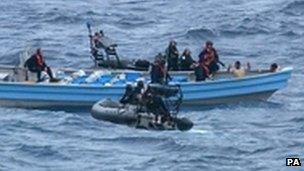Is it a good or bad sign when drugs are seized?
- Published
- comments

Cocaine is found by Royal Navy personnel
I don't know how bruised Immigration Minister Damian Green is this morning after his ticking off by the statistics watchdog.
But the more I think about the row over his use of drug seizure figures, the more I conclude that the real scandal is the simplistic nature of the debate.
Sir Michael Scholar of the UK Statistics Authority suggested in a letter, external to Mr Green yesterday that his motivation for publishing "highly selective" unofficial figures showing an increase in seizures at ports was "to generate positive news coverage" and "show the UK Border Agency in a good light" days before official stats, external covering the whole of England and Wales revealed a decline in drug busts.
This, Sir Michael wrote, "was irregular and inconsistent" with the rules on releasing government figures and, potentially, "highly corrosive and damaging to public confidence in official statistics".
The speculation about Mr Green's motivation, however, presupposes that an increase in drug seizures is good news and a fall is bad news. But is that right?
The Minister's unexpected press release last week hailed the rise as evidence of "a success" for the UKBA. "These seizures show our investigators are keeping pace with the ever changing methods of criminal gangs", the Minister said.
He published a little table to show how UKBA seizures of heroin and cocaine between April and September this year were greater than the amount seized annually in the previous two years.
But looking at the figures for annual seizures by the UKBA published in the official tables three days later, not only do the figures not match up, but a different tale emerges. Over the past 7 years, seizures of both cocaine and heroin at British ports and airports have fallen dramatically.
Are we to assume that the UKBA was at its most efficient in 2003 when it seized almost 5 tonnes of cocaine and more than a tonne and a half of heroin? Or are the figures more a reflection of the amount of narcotics criminal gangs were targeting at Britain that year?
The point is that there are all kinds of factors that may impact on drug seizures at British ports.
Sometimes a fall may be seen as good news. Indeed, Mr Green claims just that in reflecting on the previous year's drop in seizures: "In 2010 heroin seizures fell, reflecting the "poppy drought" in Afghanistan and the impact of international law enforcement activity in major distribution hubs like Turkey."
So, it is happy news when UK seizures fall and when they rise!
There is another point about the figures trumpeted by Mr Green at the beginning of last week.
The big increase in cocaine seizures claimed by the UKBA was entirely down to one huge operation in June which yielded the "largest ever haul" of the drug, found on a luxury yacht which had docked in Southampton. The 1,200 kg of 90% pure cocaine was allegedly en route to the Netherlands.
So, while the operation was undoubtedly a success in the international effort to damage and disrupt the cocaine trade, it is arguable as to whether the UKBA should count it in figures for Class A drugs it had stopped at the border.
It would also be interesting to know how much credit the agency think they can take for an operation that also involved the Serious Organised Crime Agency (SOCA) and Dutch law enforcement agencies.
It is doubtful whether drug seizure figures reflect success or failure in the attempt to control the supply of illegal narcotics and reduce drug misuse in Britain.
The point was spelled out in the opening paragraph of last week's official statistical release covering England and Wales:
"The numbers of seizures made are affected by police activity and changes in recording practices and police powers, such as the introduction of cannabis warnings. Therefore, the number of drug seizures made and quantity of drugs seized should not be taken as measures of drug prevalence in England and Wales. This is addressed in the Drug Misuse Declared publications, based on results from the British Crime Survey."
If we want to know whether the various Home Office agencies fighting the war on drugs are having any success, we should look (as advised above) at the Drug Misuse Declared, external figures which were published in July.
What this suggests is that in 2010/11, some three million adults aged 16 to 59 had used illicit drugs and that around a million had used a Class A drug. "Neither estimates were statistically significantly different from the 2009/10 survey" the experts concluded.
In other words, overall there has been no demonstrable change in the number of people using illegal drugs in the last year - a conclusion that was not deemed important enough to warrant a Home Office press release.